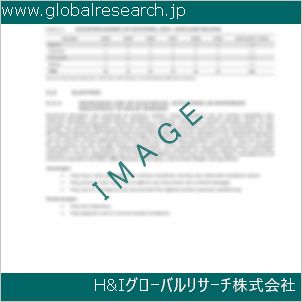Table of Contents
1 Industry Overview of N-Amylbutyrate
1.1 Definition and Specifications of N-Amylbutyrate
1.1.1 Definition of N-Amylbutyrate
1.1.2 Specifications of N-Amylbutyrate
1.2 Classification of N-Amylbutyrate
1.3 Applications of N-Amylbutyrate
1.3.1 Nuclear Application
1.3.2 Non-Nuclear Application
1.4 Industry Chain Structure of N-Amylbutyrate
1.5 Industry Overview and Major Regions Status of N-Amylbutyrate
1.5.1 Industry Overview of N-Amylbutyrate
1.5.2 Global Major Regions Status of N-Amylbutyrate
1.6 Industry Policy Analysis of N-Amylbutyrate
1.7 Industry News Analysis of N-Amylbutyrate
2 Manufacturing Cost Structure Analysis of N-Amylbutyrate
2.1 Raw Material Suppliers and Price Analysis of N-Amylbutyrate
2.2 Equipment Suppliers and Price Analysis of N-Amylbutyrate
2.3 Labor Cost Analysis of N-Amylbutyrate
2.4 Other Costs Analysis of N-Amylbutyrate
2.5 Manufacturing Cost Structure Analysis of N-Amylbutyrate
2.6 Manufacturing Process Analysis of N-Amylbutyrate
3 Technical Data and Manufacturing Plants Analysis of N-Amylbutyrate
3.1 Capacity and Commercial Production Date of Global N-Amylbutyrate Major Manufacturers in 2023
3.2 Manufacturing Plants Distribution of Global N-Amylbutyrate Major Manufacturers in 2023
3.3 R&D Status and Technology Source of Global N-Amylbutyrate Major Manufacturers in 2023
3.4 Raw Materials Sources Analysis of Global N-Amylbutyrate Major Manufacturers in 2023
4 Capacity, Production and Revenue Analysis of N-Amylbutyrate by Regions, Types and Manufacturers
4.1 Global Capacity, Production and Revenue of N-Amylbutyrate by Regions 2019-2024
4.2 Global and Major Regions Capacity, Production, Revenue and Growth Rate of N-Amylbutyrate 2019-2024
4.3 Global Capacity, Production and Revenue of N-Amylbutyrate by Types 2019-2024
4.4 Global Capacity, Production and Revenue of N-Amylbutyrate by Manufacturers 2019-2024
5 Price, Cost, Gross and Gross Margin Analysis of N-Amylbutyrate by Regions, Types and Manufacturers
5.1 Price, Cost, Gross and Gross Margin Analysis of N-Amylbutyrate by Regions 2019-2024
5.2 Price, Cost, Gross and Gross Margin Analysis of N-Amylbutyrate by Types 2019-2024
5.3 Price, Cost, Gross and Gross Margin Analysis of N-Amylbutyrate by Manufacturers 2019-2024
6 Consumption Volume, Consumption Value and Sale Price Analysis of N-Amylbutyrate by Regions, Types and Applications
6.1 Global Consumption Volume and Consumption Value of N-Amylbutyrate by Regions 2019-2024
6.2 Global and Major Regions Consumption Volume, Consumption Value and Growth Rate of N-Amylbutyrate 2019-2024
6.3 Global Consumption Volume and Consumption Value of N-Amylbutyrate by Types 2019-2024
6.4 Global Consumption Volume and Consumption Value of N-Amylbutyrate by Applications 2019-2024
6.5 Sale Price of N-Amylbutyrate by Regions 2019-2024
6.6 Sale Price of N-Amylbutyrate by Types 2019-2024
6.7 Sale Price of N-Amylbutyrate by Applications 2019-2024
6.8 Market Share Analysis of N-Amylbutyrate by Different Sale Price Levels
7 Supply, Import, Export and Consumption Analysis of N-Amylbutyrate
7.1 Supply, Consumption and Gap of N-Amylbutyrate 2019-2024
7.2 Global Capacity, Production, Price, Cost, Revenue, Supply, Import, Export and Consumption of N-Amylbutyrate 2019-2024
7.3 USA Capacity, Production, Price, Cost, Revenue, Supply, Import, Export and Consumption of N-Amylbutyrate 2019-2024
7.4 EU Capacity, Production, Price, Cost, Revenue, Supply, Import, Export and Consumption of N-Amylbutyrate 2019-2024
7.5 China Capacity, Production, Price, Cost, Revenue, Supply, Import, Export and Consumption of N-Amylbutyrate 2019-2024
7.6 Japan Capacity, Production, Price, Cost, Revenue, Supply, Import, Export and Consumption of N-Amylbutyrate 2019-2024
8 Major Manufacturers Analysis of N-Amylbutyrate
8.1 Manufacturer One
8.1.1 Company Profile
8.1.2 Product Picture and Specifications
8.1.2.1 Type I
8.1.2.2 Type II
8.1.2.3 Type III
8.1.3 Capacity, Production, Price, Cost, Gross and Revenue
8.1.4 Contact Information
8.2 Manufacturer Two
8.2.1 Company Profile
8.2.2 Product Picture and Specifications
8.2.2.1 Type I
8.2.2.2 Type II
8.2.2.3 Type III
8.2.3 Capacity, Production, Price, Cost, Gross and Revenue
8.2.4 Contact Information
8.3 Manufacturer Three
8.3.1 Company Profile
8.3.2 Product Picture and Specifications
8.3.2.1 Type I
8.3.2.2 Type II
8.3.2.3 Type III
8.3.3 Capacity, Production, Price, Cost, Gross and Revenue
8.3.4 Contact Information
8.4 Manufacturer Four
8.4.1 Company Profile
8.4.2 Product Picture and Specifications
8.4.2.1 Type I
8.4.2.2 Type II
8.4.2.3 Type III
8.4.3 Capacity, Production, Price, Cost, Gross and Revenue
8.4.4 Contact Information
8.5 Manufacturer Five
8.5.1 Company Profile
8.5.2 Product Picture and Specifications
8.5.2.1 Type I
8.5.2.2 Type II
8.5.2.3 Type III
8.5.3 Capacity, Production, Price, Cost, Gross and Revenue
8.5.4 Contact Information
…
9 Marketing Trader or Distributor Analysis of N-Amylbutyrate
9.1 Marketing Channels Status of N-Amylbutyrate
9.2 Traders or Distributors with Contact Information of N-Amylbutyrate by Regions
9.3 Ex-work Price, Channel Price and End Buyer Price Analysis of N-Amylbutyrate
9.4 Regional Import, Export and Trade Analysis of N-Amylbutyrate
10 Industry Chain Analysis of N-Amylbutyrate
10.1 Upstream Major Raw Materials Suppliers Analysis of N-Amylbutyrate
10.1.1 Major Raw Materials Suppliers with Contact Information Analysis of N-Amylbutyrate
10.1.2 Major Raw Materials Suppliers with Supply Volume Analysis of N-Amylbutyrate by Regions
10.2 Upstream Major Equipment Suppliers Analysis of N-Amylbutyrate
10.2.1 Major Equipment Suppliers with Contact Information Analysis of N-Amylbutyrate
10.2.2 Major Equipment Suppliers with Product Pictures Analysis of N-Amylbutyrate by Regions
10.3 Downstream Major Consumers Analysis of N-Amylbutyrate
10.3.1 Major Consumers with Contact Information Analysis of N-Amylbutyrate
10.3.2 Major Consumers with Consumption Volume Analysis of N-Amylbutyrate by Regions
10.4 Supply Chain Relationship Analysis of N-Amylbutyrate
11 Development Trend of Analysis of N-Amylbutyrate
11.1 Capacity, Production and Revenue Forecast of N-Amylbutyrate by Regions and Types
11.1.1 Global Capacity, Production and Revenue of N-Amylbutyrate by Regions 2024-2029
11.1.2 Global and Major Regions Capacity, Production, Revenue and Growth Rate of N-Amylbutyrate 2024-2029
11.1.3 Global Capacity, Production and Revenue of N-Amylbutyrate by Types 2024-2029
11.2 Consumption Volume and Consumption Value Forecast of N-Amylbutyrate by Regions, Types and Applications
11.2.1 Global Consumption Volume and Consumption Value of N-Amylbutyrate by Regions 2024-2029
11.2.2 Global and Major Regions Consumption Volume, Consumption Value and Growth Rate of N-Amylbutyrate 2024-2029
11.2.3 Global Consumption Volume and Consumption Value of N-Amylbutyrate by Types 2024-2029
11.2.4 Global Consumption Volume and Consumption Value of N-Amylbutyrate by Applications 2024-2029
11.3 Supply, Import, Export and Consumption Forecast of N-Amylbutyrate
11.3.1 Supply, Consumption and Gap of N-Amylbutyrate 2024-2029
11.3.2 Global Capacity, Production, Price, Cost, Revenue, Supply, Import, Export and Consumption of N-Amylbutyrate 2024-2029
11.3.3 USA Capacity, Production, Price, Cost, Revenue, Supply, Import, Export and Consumption of N-Amylbutyrate 2024-2029
11.3.4 EU Capacity, Production, Price, Cost, Revenue, Supply, Import, Export and Consumption of N-Amylbutyrate 2024-2029
11.3.5 China Capacity, Production, Price, Cost, Revenue, Supply, Import, Export and Consumption of N-Amylbutyrate 2024-2029
11.3.6 Japan Capacity, Production, Price, Cost, Revenue, Supply, Import, Export and Consumption of N-Amylbutyrate 2024-2029
12 New Project Investment Feasibility Analysis of N-Amylbutyrate
12.1 New Project SWOT Analysis of N-Amylbutyrate
12.2 New Project Investment Feasibility Analysis of N-Amylbutyrate
13 Conclusion of the Global N-Amylbutyrate (CAS 540-18-1) Industry 2024 Market Research Report
| ※参考情報 N-酪酸アミル(N-Amylbutyrate)は、化学式C5H10O2を持つエステル化合物であり、通常は無色または淡黄色の液体として存在します。CAS番号は540-18-1で、特有の果実のような香りを持つことが特徴です。この化合物は、食品香料や香水の製造において広く利用されており、その香りの特性から多くの商業的用途があります。 N-酪酸アミルは、特にその調和のとれたフルーティーなアロマが評価されており、さまざまな香料のブレンドにおいて重要な役割を果たします。これにより、飲料や食品の香り付けに利用されているほか、化粧品やパーソナルケア製品にも使用されています。また、アミル部分は、ブチル部分との化学的結合により、特有の香りと風味が生まれます。 この化合物は、エステルの一種であり、通常はアルコールとカルボン酸から合成されます。具体的には、アミルアルコールと酪酸の反応によって生成されます。この反応は、酸触媒の存在下で進行し、エステル結合が形成される過程です。合成プロセスは比較的簡便であり、工業的に生産される場合もあります。 N-酪酸アミルの用途は多岐にわたります。食品業界では、特に飲料やデザート、菓子類などの香料として使用されています。果実味が求められる製品において、その特有の甘くてフルーティーな風味が活かされています。さらに、加工食品や冷凍食品においても、風味の強化や保存性の向上を目的として使用されることがあります。 また、N-酪酸アミルは化粧品や香水の分野でも重要な成分として利用されています。フレグランス業界では、香りのバランスを整えるために、複雑な香料のブレンドの中でしばしば使用されます。その優れた香りの特性により、製品全体の完成度を高める役割を果たしています。 環境面でも、N-酪酸アミルは重要な役割を果たしています。生分解性が高いため、環境への負荷が比較的低いとされています。この特性は、持続可能な製品開発が求められる現代において特に注目されており、エコフレンドリーな香料の選択肢として評価されています。 さらに、N-酪酸アミルは工業的にも炭化水素の代替としての可能性を秘めています。多くの合成化学反応が必要とされる中で、より持続可能で低環境影響の合成ルートを模索する動きがあります。この点において、N-酪酸アミルは新しい合成方法の一環として研究されており、さまざまな応用の可能性があります。 まとめると、N-酪酸アミルは、その特有のフルーティーな香りから、食品、香料、化粧品など多岐にわたる分野で利用されています。その生分解性や持続可能性に配慮した特性から、環境に優しい材料としての評価も高まっています。また、合成や加工のプロセスにおいても、その利用は今後さらに広がっていくことでしょう。このように、N-酪酸アミルは化学工業や日常生活において重要な存在であり、今後も研究や開発の対象となることが期待されます。 |
❖ 免責事項 ❖
http://www.globalresearch.jp/disclaimer












